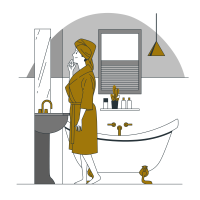The Colosseum

The amphitheatre is called Amphitheatrum Flavium in Latin and simply Amphitheatrum in Italian (Anfiteatro). It is the largest Roman amphitheatre in the world, with an estimated capacity of between 50,000 and 87,000 spectators. This would put it right at the heart of Rome's most impressive Roman amphitheatre, which is also the most impressive relic of ancient times to have come down to us today.
It was inscribed on the UNESCO World Heritage List in 1980, together with the entire historic centre of Rome, the extraterritorial properties of the Holy See in Italy and the Basilica of St Paul Outside the Walls. Later, in 2007, it was chosen as one of the New Seven Wonders of the World in a competition organised by the New Open World Corporation (NOWC). Built during the reign of Flavian on land on the eastern edge of the Roman Forum, the amphitheatre was begun by Vespasian in 70 AD and completed by Titus, who inaugurated it on 21 April 80 AD. Its construction was finally completed, with some modifications, by Domitian in 90 AD.
History in perspective
Begun in the years 70 to 72 by Emperor Vespasian of the Flavian dynasty, it was paid for, like all other public works of the time, by provincial taxes and also by the spoils of the conquest of the Temple of Jerusalem in 70. The site chosen was in the hollow between Velia, Oppio Hill and Celio, where there was an artificial lake - which the poet Martial calls "the stagnum" - dug by Nero for his Domus Aurea. The pool, or rather the body of water, was fed by springs coming from the base of the Temple of the Divine Claudius on Celio. Vespasian hid it as a work of reparation to reverse the tyrant's policies. Nero had privatised public land for his own use, showing what came before and what would come after in terms of forms of government. Vespasian redirected the aqueduct for civic use, restored the lake and improved the foundations on which the Cavea was built.
Before his death in 79, Vespasian saw to the completion of the first two levels and successfully inaugurated the structure. This was the first great permanent amphitheatre in Rome, after two smaller or more temporary ones from the Julio-Claudian period (the Amphitheatre of Taurus and the Amphitheatre of Caligula), and it was built a full 150 years after the first amphitheatres had been built in Campania. Titus also raised the seating to the third and fourth levels and officially inaugurated it with 100 days of play in 80. Soon after, massive changes were made by Vespasian's other son, the Emperor Domitian, who is credited with completing the ad clipea - probably gilded bronze shields - and possibly adding the maenianum summum in ligneis, as well as building the underground passageways of the arena. After these improvements, the amphitheatre was no longer used for naumachiae, or the staging of naval battles, which, according to historical sources, had taken place shortly before.
Along with the construction of the amphitheatre, several other structures were built for the games: the ludi (which were used as barracks and training grounds for gladiators - Magnus, Gallicus, Matutinus and Dacicus), barracks for the contingent of sailors from the Classis Misenensis - the Roman fleet stationed in Miseno, which operated the velarium (castra misenatium), the summum choragium and the armamentaria - stores for weapons and equipment. There was also a sanatorium - a place to treat wounds received in battle - and a spoliarium, where the remains of gladiators killed in battle were kept. The building is in the shape of a polycentric oval, with an area of 527 metres at its longest, 187.5 metres at its widest and 156.5 metres at its two axes. The interior of the arena measures 86 by 54 metres, giving a total area of 3,357 square metres.
What now rises out of the ground to form this structure is 48 metres high, although it was originally 52 metres high. This structure clearly speaks of the true nature-built principles of Roman architectural and engineering designs during their early imperial period, with the grand embracing line of the elliptical plan and the detailed construction methods used. The arches and vaults are structurally interrelated in an interesting way. In ancient times, gladiatorial games were held here. Different types of shows could be seen by the public; animal hunts and naumachiae, sea battles, re-enactments of famous battles and dramas based on mythology. It fell into disuse after the 6th century, but over time found various uses, most notably as a quarry. Today it is a symbol of Rome and, as an archaeological monument that can be visited, one of its main attractions.
 Ancient Roman Empire Colosseum
Ancient Roman Empire Colosseum
The Imperial Era
Work by Nerva and Trajan is attested by several inscriptions, but it was under Antoninus Pius that the first phase of restoration began. In 217, probably due to a fire caused by lightning, the upper structures were damaged, resulting in the closure of the Colosseum for 5 years between 217 and 222, during which time the games were held in the Circus Maximus. The restoration begun by Heliogabalus (218-222) was continued by Alexander Severus, who rebuilt the colonnade on the summa cavea.
Although the building was reopened in 222, it was not until the reign of Gordian III that the restoration could be considered complete—a fact seemingly confirmed by the coinage of these two emperors. Another fire in 250, again caused by lightning, prompted Emperor Decius to order repairs. After the Visigoths sacked Rome in 410 under Alaric, it is thought that an inscription in honour of the Emperor Honorius was added to the podium surrounding the arena as part of the restoration work. It was Honorius who stopped the gladiatorial games and later allowed hunting shows to take their place in the arena.
The inscription was removed after some time and replaced to mark another major restoration, following an earthquake in 442, under praefecti urbi Flavius Sinesius Gennadius Paulus and Rufius Cecina Felix Lampadius. Constantius II found it very much to his liking. Further restoration was carried out in 470 by the consul Messio Febo Severo after another earthquake. Work continued even after the fall of the Western Roman Empire; after another earthquake in either 484 or 508, Decio Mario Venanzio Basilio, then praefectus urbi, personally paid for the restoration.
The venationes continued until the time of Theodoric. Gradus has inscribed the names of the great senatorial houses of Odoacer's time; although this is an ancient custom, the names were constantly being erased and replaced by those of new occupants according to the various orders of clarissimi, spectabilis and illustres sitting. All that remains are the names of the last issue before the fall of the Empire.

From medieval to modern times
It was first used as a necropolis in the 6th century and later as a castle. Between the 6th and 7th centuries, a chapel was built inside the Colosseum, now known as Santa Maria della Pietà al Colosseo. Around 847, during the reign of Pope Leo IV, an earthquake caused serious damage to the structure.
It was mainly the southern outer wall that collapsed during a major earthquake in 1349 - this part had been built on less firm alluvial soil. In the 13th century, the Colosseum was used as a quarry and was also the site of a palace belonging to the Frangipane family, which was later demolished, but it was never uninhabited - the Colosseum continued to house many other human dwellings. During the 15th and 16th centuries, travertine blocks were systematically removed as new buildings were constructed. In 1451, the travertine, asproni and marble of the Colosseum were excavated, crushed and taken to the lime kilns of Pope Nicholas V. The work was commissioned by M° Giovanni di Foglia Lombardo.
The stones that fell to the ground were used to build Palazzo Barberini in 1634 and, after another earthquake in 1703, to build the port of Ripetta. Benvenuto Cellini, in his autobiography, recounts a terrifying night among the spirits raised within the confines of the Colosseum to prove how evil and ominous the place was. During the Jubilee year of 1675, the place was consecrated in memory of the many Christian martyrs who suffered there. It was a decree by Pope Benedict XIV in 1744 that stopped the plundering and gave rise to fourteen shrines of the Via Crucis on the site; in 1749 he also declared the Colosseum a church dedicated to Christ and the Christian martyrs.
Modern times: Bringing back the 19th century
The Colosseum had already been excavated in two major phases - first by Carlo Fea, the Commissioner of Antiquities, in 1811 and 1812, then by Pietro Rosa between 1874 and 1875 - making it the subject of various imaginative reuse projects until the mid-eighteenth century.
At the end of the nineteenth century, after centuries of use - including a period of Christian worship within its walls and use as a travertine quarry - this great structure was left on very precarious foundations. The most obvious problem is the abrupt discontinuity of the outer ring along the sections adjacent to today's streets - Via di San Giovanni in Laterano and Via dei Fori Imperiali - especially where major restorations have taken place. Fea also records what may be the origin of the holes in the monument's stones - probably part of a mechanism for extracting metal clamps that held the stones together.

Origins of the present name
Colosseum became popular in the early Middle Ages, probably from a common vulgarisation of the Latin adjective ‘colosseum,’ meaning colossal, in the midst of the one- and two-storey dwellings that were added at that time. It is more likely, however, that the name comes from the colossal statue of Nero nearby. The building soon became the symbol of a city of an empire, where ideology, the desire to celebrate, traced the standards of public leisure and entertainment.
Nearby stood a large bronze statue of Nero, from whom the Colosseum is said to have taken its name, a connection that has been recorded since the Middle Ages, and which also refers to the gigantic size of the building. After Nero's death, the statue was transformed into that of Sol Invictus, the sun god, with the rays of a solar crown added around his head. In 126 it was moved from its original place in the atrium of the Domus Aurea by Hadrian to make way for the Temple of Venus and Rome.
There is a modern tuff base that marks where the foundation of the colossal statue was after it was moved. At the time of the Empire, the huge statue of Nero was taken down and it is unlikely that anyone from the 6th century would have remembered it. In the 14th century, the notary and judge Armannino da Bologna said that the Colosseum was the most important pagan place in the world.
His words mean that "the Colosseum had become the headquarters of various sects of magicians and devil worshippers" people who approached were asked with "Colis Eum?" (which means 'Do you worship him?Later, Pope Benedict XIV had the Colosseum purified by an exorcism and gave it a new use in memory of the suffering of Christ and all the saints.

The structure
The base sits on a stone floor raised above the surrounding land. Its roots are in a large piece of tuff, about 13 metres thick, which is covered on the outside by a brick wall. The supporting structure is made up of travertine stone columns connected by pins. After the building fell into disuse, it became customary to remove these metal pieces in order to melt and reuse them, so the blocks were excavated at their joints.
This is the reason for the many holes that can be seen on the external façade. The pillars are connected by walls made of tuff blocks in the lower part and bricks in the upper part. The Cavea is supported by trapezoidal barrel vaults and arches resting on travertine columns and radial partitions in tuff or brick. On the outside, travertine is used, which can be seen in a series of concentric rings that support the cavea.
These curtain walls are decorated with a series of arches framed by pilasters. The groined vaults are among the first in the Roman world, made of opus caementicium and very often with ribs of intersecting brick arches, also used in the facings. In addition, the radial walls outside the two outer ambulacra are reinforced with tuff blocks. An advanced water supply and drainage system helped maintain the building and supplied water to the fountains located in the cavea for the public.

External façade
The external façade (which reaches 48.50 metres) is made of travertine and is arranged in four orders, following the typical pattern of all the pleasure buildings in the Roman world: the lower three levels are made up of 80 numbered arches supported by semi-columned columns. The fourth level (attic) consists of a solid wall with pilasters corresponding to the columns of the arches. The columns on each level are Doric, Ionic and Corinthian. The top floor is also Corinthian.
The wall sections between the pilasters contain 40 small square windows, one every two bays (the solid bays were always fitted with bronze clamps). Above the windows, each bay has three projecting consoles. These consoles housed the wooden rods used to open and close the skylights. They were probably anchored to the ground by a series of sloping stone blocks. These entrances can still be seen today on the outer edge of the travertine terrace on which the Colosseum stands (the one on the Celio side is clearly visible). The first terraced level contained 80 entrances, including four special entrances along the elliptical axis.
The short axis contained entrances to the VIP stands (the Emperor's Entrance); the long axis contained entrances directly to the arena. Different floors were reserved for different social classes. The emperor sat in the morning on a platform facing the Arch of Constantine and in the afternoon on a platform facing what is now a metro station. The arches on the second and third floors were framed by continuous parapets with semi-columns with cubic bases.
The four styles of semi-columns and pilasters, from bottom to top, had Tuscan, Ionic, Corinthian and smooth Corinthian capitals. The first three styles repeat the same order, a sequence also seen on the façade of the Theatre of Marcellus. The coins show four arches at either end of the elliptical axis of the plan, decorated with a small marble portico.

The velarium
The Colosseum had a fabric roof, called the velarium, made up of many sheets which, according to some scholars such as Manzione, covered the spectator stands, leaving the central arena open to the sky. This would have provided shade for the spectators only at midday; at all other times of the day, different parts of the stands would have continued to receive direct sunlight. Other scholars (D'Anna and Molari) proposed a completely covered version, including the arena. The velarium was designed to protect spectators from the sun and was operated by a group of sailors from the Miseno fleet, which was based next to the Colosseum.
A sophisticated system of ropes and pulleys was used to keep the sheets in place. Manzione and others believe that the whole thing was held in place by ropes attached to blocks of stone outside the Colosseum, some of which can still be seen today. However, when people recently dug around there, they found that these blocks don't have any foundations, so this idea has been discarded.

Access to the auditorium and public areas
The cavea consists of marble seats and steps for the spectators. It is made entirely of marble and is divided by praecinctiones or baltea (partitions) into five horizontal sections (maeniana) assigned to different categories of spectators in ascending order - the rank diminishing as one goes higher, it seems. In the upper part there were wide, low steps for wooden seats (subsellia) where the senators and their families sat, and the names of the senators who were allocated these lower seats were inscribed on the balustrade of the podium. Next was the maenianum primum, with about twenty marble steps, and the maenianum secundum, divided into imum (lower) and summum (upper), each with about sixteen marble steps. Inside the colonnaded portico that crowned the cavea (porticus in summa cavea), there were about eleven wooden steps.
What remains architecturally belongs to a renovation of the Severan or Gordian III period. It was on these steps that the women sat under a roof, separated from the rest of the spectators since the time of Augustus. The most undesirable place to sit was on the terrace above the colonnade, where standing room was reserved for the lowest orders of plebs. The stairs and entrances to the cavea divided the sectors vertically. They were protected by marble barriers dating from the 2nd century restoration. At each end of the minor axis, which was preceded by a frontal section, there were two boxes for important persons, which have now disappeared. One box, in the shape of a "S", was for the emperor, the consuls and the vestal virgins; the other was for the praefectus urbi and other dignitaries. After passing through the proper entrance arches, they went to their seats.
The emperors and officials exercised their right to reserved entrances on the minor axis of the oval, while the central entrances on the major axis were reserved for actors and leading characters of performances. All other spectators had to queue under this archway according to their ticket number, so each public archway had a number inscribed on the keystone. Such a numbering would make it easier and quicker to reach one's seat. The numbers carved into the arches of the Colosseum were painted red to make them more visible from a distance.
This detail came to light during the restoration work financed by the Tod's group, when the façade was cleaned with water fog to remove dirt and smog deposits and bring to light some very faint traces of colour. From here, a series of intersecting staircases led to a symmetrical arrangement of vaulted circular corridors. Each of these led to a large tripartite wedge divided by pilasters, marble-clad passage walls and a vaulted ceiling with stucco decoration, original to the Flavian period. In addition, the southern stage of the Emperor has another entrance through a cryptoporticus that leads directly outside. Twelve arches opened into corridors used by those seated in the innermost ring, from which a short staircase led down to the lower part of the cavea. These passages were also covered with marble. The remaining arches gave access to several single or double staircases leading to the upper areas. In this area, the walls were covered with plaster, even reaching the vaults.

The arena and service areas below
The oval-shaped arena (86 m x 54 m) was built of brick and wood and covered with sand, which was frequently cleaned to absorb the blood of the killers. The arena was separated from the spectator stands by a platform about 4m high, decorated with niches and marble, and protected by a bronze railing. Behind the platform were the main seats. The arena contained various traps and lifts leading to underground passages for use during performances.
Below the arena were the service areas (catacombs), divided into a large central passage along the main axis and twelve symmetrically arranged curved corridors on either side. Elevators were used to bring machines or animals used in the games into the arena. There were 80 lifts distributed over four corridors. Surviving remains indicate that the building was rebuilt in the 3rd or 4th century AD. Comparisons with the underground passages of the Flavian Amphitheatre at Pozzuoli (built by the same architect as the Colosseum) give an idea of what the underground passages of the Colosseum might have looked like in Roman times. In Pozzuoli, the devices used by the Romans to transport cages of wild animals into the arena can still be seen. The roof of the underground passageways no longer exists, so that the rooms beneath the arena are still visible today. The service buildings below the arena had separate entrances:
The underground galleries at the end of the main axis led to the central passageway under the arena, which was used to transport animals and machinery. Two massive arched entrances on the main axis led directly into the arena, allowing access for the protagonists (pompa), gladiators and animals too heavy to be lifted through the underground passages. Staff could also enter the arena through open passages in the service galleries, which encircled the arena and were located under the podium beneath the auditorium. The innermost circular corridors led to the gallery, where the senators sat.

Santa Maria della Pietà at the Colosseum
Inside the Colosseum is the church of Santa Maria della Pietà al Colosseo, a place of Catholic worship. It is a simple church built in one of the arches of the Flavian amphitheatre. Its foundation can be dated between the sixth and seventh centuries, but probably not, since the first sure news of its existence dates back to the fourteenth century.
It has always been a place of worship in memory of the Christian martyrs who died inside the Colosseum, and many saints have visited it—St. Ignatius of Loyola, St. Philip Neri, St. Camillus de Lellis—to name but a few. According to the Roman archaeologist Mariano Armellini, "the chapel was originally a dressing room for the troupe that performed the important drama of the Passion of Christ in the amphitheatre until the time of Pope Paul IV. " In 1622, therefore, the sanctuary came into the possession of the Confraternita del Gonfalone, which built the oratory there and installed a monk as custodian to take care of the place. In 1936 the Vicariate of Rome entrusted the Circolo San Pietro with the care of the liturgy of this church.

The Gladiator Games
The Colosseum hosted amphitheatre-style sports, including animal fights (venationes), executions by wild animals or other methods (noxii), and gladiator fights (munera). These events followed a fixed schedule: fights between animals or between gladiators and animals in the morning, executions at noon, and gladiatorial fights in the afternoon.
To celebrate the completion of the Colosseum, Emperor Titus organised a three-month series of games involving some 2,000 gladiators and 9,000 animals. To celebrate Trajan's victory over the Dacians, 10,000 gladiators took part.
The last recorded gladiatorial combat took place in 437 AD. However, the amphitheatre continued to be used for animal slaughter until the reign of Theodoric the Great: the last gladiatorial fights took place in 519 during the reign of Eutalic (Theodoric's son-in-law) and again in 523 during the reign of Anisius Maximus. Excavations in the sewers of the Colosseum have revealed the remains of many domestic and wild animals, including bears, lions, horses and ostriches.
Services and Accessibility

Wheelchair accessible

Toilets

Bookshop

Refreshment point

Baby Pit Stop

